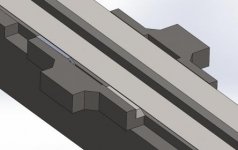I'm not sure if this is the correct forum section however I believe members with potentially the most knowledge about the subject hangs here 
I'm making a few sketches for a small 3-4hp toolroom lathe with about ø150x400mm capacity between centers.
The bed is 200mm wide and has 30° taper on each 25x75mm rail. Carriage is guided by the top of the rails and the outer tapered edges. Tail stock is guided by the top of the rails and the inner edges.
The carriage is 400mm long and I plan to use 125mm long 1° tapered gibs, one in each end of the carriage. The gibs adjustment mechanism is still not implemented.
Questions;
- 1° taper and 125mm length in the ballpark for this kind of application?
- Will it for some reason be problematic to use two gibs instead of one?
- Other suggestions?
Thanks!




I'm making a few sketches for a small 3-4hp toolroom lathe with about ø150x400mm capacity between centers.
The bed is 200mm wide and has 30° taper on each 25x75mm rail. Carriage is guided by the top of the rails and the outer tapered edges. Tail stock is guided by the top of the rails and the inner edges.
The carriage is 400mm long and I plan to use 125mm long 1° tapered gibs, one in each end of the carriage. The gibs adjustment mechanism is still not implemented.
Questions;
- 1° taper and 125mm length in the ballpark for this kind of application?
- Will it for some reason be problematic to use two gibs instead of one?
- Other suggestions?
Thanks!








